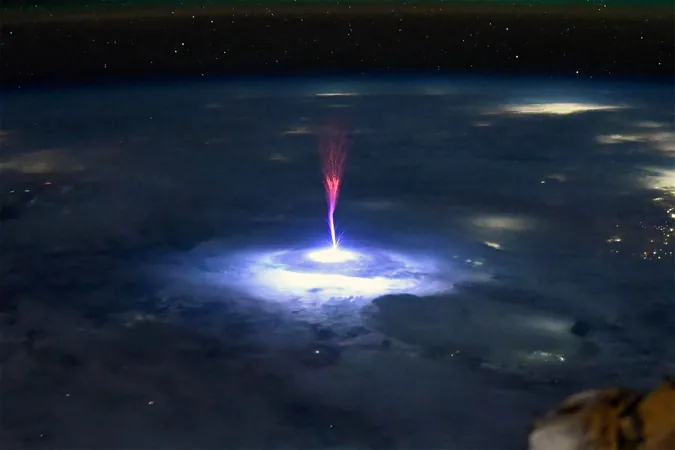
NASA's Stunning Photos Capture Mysterious Lightning Events Above Earth
2025-08-19
Author: Ting
Unveiling the Mysteries of Transient Luminous Events
While we may only see lightning bolts and hear thunder during storms, astronauts aboard the International Space Station (ISS) have witnessed an otherworldly spectacle: brilliantly-colored electric flashes known as transient luminous events (TLEs), erupting as high as 55 miles above the Earth's surface.
These visual marvels—featuring blue jets, red sprites, and violet halos—were historically difficult to study, often relegated to anecdotal tales or rare photographs. However, the ISS provides an unprecedented vantage point that allows researchers to observe these phenomena with specialized cameras and sensors.
The Groundbreaking Role of ASIM
At the heart of this exploration is the Atmosphere–Space Interactions Monitor (ASIM), developed by the European Space Agency and installed on the ISS since 2018. This sophisticated piece of technology captures lightning-like discharges and the fleeting bursts that typically go unnoticed.
Early data revealed astonishing insights: certain electrical discharges at the tops of thunderclouds can generate massive ultraviolet rings known as ELVES, which influence the ionosphere and interfere with radio communications.
The Enigma of Red Sprites and Blue Jets
Among the captivating phenomena being monitored are the elusive 'red sprites.' These strange, jellyfish-like flashes glow for mere milliseconds, while 'blue jets' shoot skyward with eerie intensity. The ability of ASIM to document these rapid events marks a significant breakthrough in atmospheric science.
Vivid Storm Tracking from the ISS
The ISS cupola, a stunning observation dome that features in numerous astronaut selfies, is now part of scientific research through the Thor-Davis experiment. Crewmembers use advanced cameras to capture storms at staggering rates of up to 100,000 frames per second. This slow-motion footage provides unprecedented details, assisting scientists in understanding complex lightning behavior.
Mapping the Hidden Drama of Lightning
Additionally, lightning isn't just visible; it can generate terrestrial gamma-ray flashes, bursts of high-energy radiation comparable to a chest X-ray. The Japan Aerospace Exploration Agency’s Light-1 CubeSat scans for these invisible events, aiming to create a 3D map of gamma-ray bursts in the atmosphere.
The Broader Impact of Atmospheric Phenomena
These unusual flashes might appear to be mere curiosities, but they can disrupt radio signals critical for communication, affecting everything from aircraft operations to submarine communications. Understanding their occurrence and behavior is crucial for enhancing safety standards in aviation and improving climate models.
A Future of Advanced Lightning Detection
With the ISS continuing its mission, ASIM and its future successors will amass a database of previously invisible atmospheric phenomena. Plans are underway for next-gen sensors to enhance data collection across a wider spectrum, improving real-time alerts for weather agencies when these electrical discharges occur.
The lessons learned from above not only deepen our appreciation of Earth's weather systems but also bring us closer to predicting and mitigating the unexpected electric surprises that storms can unleash.
Stay Updated on the Latest Discoveries!
If you found this article fascinating, consider subscribing to our newsletter for exclusive updates and engaging content on the wonders of our universe!





 Brasil (PT)
Brasil (PT)
 Canada (EN)
Canada (EN)
 Chile (ES)
Chile (ES)
 Česko (CS)
Česko (CS)
 대한민국 (KO)
대한민국 (KO)
 España (ES)
España (ES)
 France (FR)
France (FR)
 Hong Kong (EN)
Hong Kong (EN)
 Italia (IT)
Italia (IT)
 日本 (JA)
日本 (JA)
 Magyarország (HU)
Magyarország (HU)
 Norge (NO)
Norge (NO)
 Polska (PL)
Polska (PL)
 Schweiz (DE)
Schweiz (DE)
 Singapore (EN)
Singapore (EN)
 Sverige (SV)
Sverige (SV)
 Suomi (FI)
Suomi (FI)
 Türkiye (TR)
Türkiye (TR)
 الإمارات العربية المتحدة (AR)
الإمارات العربية المتحدة (AR)